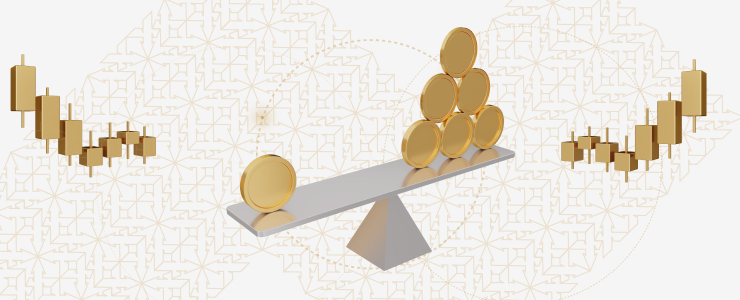Many traders tend to focus on stocks and bonds when trying to build their trading portfolio. These financial assets are important; however, there are also commodities like gold, oil, agricultural products, or metals that can balance a portfolio.
When inflation increases or central banks are about to increase interest rates, commodities usually react in a positive way. Therefore, more exposure can help protect your portfolio. If markets are overvalued, commodities can provide protection, but for portfolios that focus on growth, exposure should be more targeted and smaller.
In this article we’ll look at what commodities are and why they are important, how they work within a trading portfolio, as well as how to use them to enhance your trading strategy overall.
What are commodities?
Commodities are physical products like raw goods and resources used to produce things we need on a daily basis in our lives. These goods include oil and natural gas which are energy products, gold, silver, and copper which are metals as well as agricultural items like wheat, coffee or cotton.
By contrast to stocks and bonds, the products mentioned above react in a different way since they are closely connected to production and consumption in the real world. This difference is what makes them important in portfolio diversification. During inflation periods for example, prices usually change in ways that do not match stocks or bonds.
How commodities help diversify your trading portfolio?
Commodities are usually added in a trader’s portfolio because of their ability to spread risk. The broader idea is that by combining assets that do not move in the same direction you minimise the risk of your whole portfolio dropping all at the same time.
Commodities usually move in a different way than stocks and bonds. Therefore, when the latter go down, the former might remain stable or even go up, which helps protect your portfolio. In other words, including commodities in your portfolio can bring more balance and less risk in your trading.
Based on research, commodities’ performance is not always good but there are specific cases like inflation periods or periods with big changes in the economy, that can strengthen your portfolio’s overall results.

How do commodities react to different market conditions?
Since commodities are highly connected to supply and demand in real life, they react to things that the majority of the other financial assets would not. For example, when inflation rises, the cost of raw materials tends to rise too. That because these are used to produce everyday goods.
Climate disturbances, geopolitical events, or trade policy changes can all have a great impact on the value of commodities. Agricultural prices could increase if a drought lowers crop production, for example. Likewise, a drop in oil supply could make energy prices go up. Although these events can have a big impact, they also provide many opportunities when traders prepare well.
As a result, when inflation is high or the economy is recovering and people need more raw materials, commodities usually perform well. Many analysts acknowledge and observe that assets generally perform better during periods of higher inflation or rising interest rates.
Four reasons to include commodities in your trading portfolio
- Hedging against inflation: When inflation is high, traditional assets such as bonds tend to drop in value. As already mentioned though, commodities are tied to goods and services. Therefore, they usually go up or maintain their value.
- Enhanced diversification: Commodities behave differently compared to stocks and bonds. Therefore, including them in your portfolio can help reduce volatility and risk and smooth performance by making returns more stable.
- Global economic opportunities: Commodities allow you to trade sectors like infrastructure, energy, or farming, which gives you more ways to grow your portfolio.
- Independent trading options: Most of the time, supply and demand factors are what drive commodity prices instead of equity or bond markets, which can help diversify your portfolio
Also, there is usually higher leverage offered in commodity trading than stock trading. This increases the potential to generate revenue. It also increases the possibility of excessive losses. If the market moves against the trader’s expectations, overtrading can become an issue.

Commodity risks to keep in mind
Since nothing is perfect, neither are commodities, which come with some risks. To start with, their prices can be highly volatile. Changing sharply because of supply shocks, weather disturbances or changes in policy. This increases the possibility of losses. Although commodities are a way to hedge against inflation, timing and market conditions are also important.
Also, trading commodities could be expensive and difficult as some involve storage fees, if they are physical, or futures contracts. Having a poor understanding of these factors can lead to issues. Last but not least, when there are extreme crises in the markets or in times of market stress. With various assets may move together which can reduce the common diversification value that give.
How to use them in your trading strategy?
Decide on a clear target as to whether you are using commodities for diversification, inflation, hedging, or speculation.
Choose whether you will trade commodity futures, via CFDs or ETFs that track commodity indexes.
Commodities should take up a small percentage of your portfolio because a big one can increase risks.
Keep track of inflation, interest rates, geopolitical events and supply and demand development since they are usually what moves commodities.
Adjust accordingly because like with all asset classes, price swings might cause your commodity position to deviate from your intended plan.

Using commodities for long-term trading
Other than short-term advantages, commodities are also useful when planning your long-term portfolio. Gold, for instance, has historically been considered a safe haven asset. During periods of market uncertainty, traders usually turn to gold because it is a store of value, meaning that even if stocks or bonds drop, investing in the right commodity can help reduce losses.
Oil or industrial metals can expose you to global economic growth trends. For example, when developing economies grow, there is also increased demand for energy and raw materials, which can be of great use to traders that like to hold positions in these markets.
There are also agricultural commodities, like coffee or sugar, that also play a key role in trading, as their prices often increase because of supply shocks after weather or production issues. Their prices are unpredictable and usually move differently from traditional instruments. This makes them useful for portfolio diversification.
Final thoughts
Although commodities do not grab the same attention as stocks, they add real value to a trading portfolio by spreading risk, hedging against inflation and giving the necessary exposure to major market trends. They do not replace stocks and bonds, they complement them. With a solid trading plan and strategy, modest allocation and clear target, commodities can help balance your portfolio while keeping it strong.
Disclaimer: This information is not considered investment advice or an investment recommendation, but instead a marketing communication.



